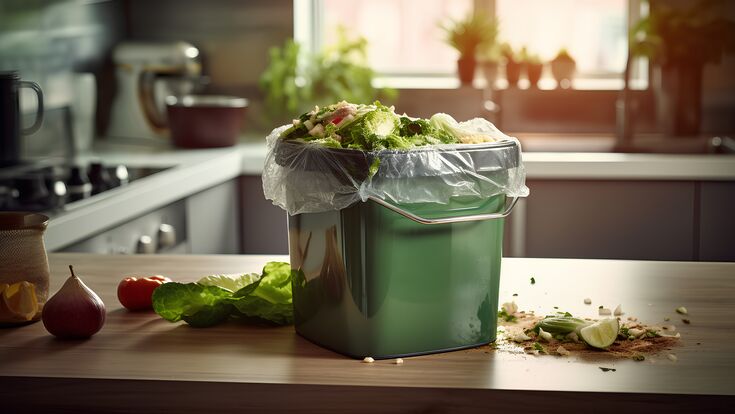Organic waste : Why - and how - biowaste should be collected separately

Biowaste is the largest fraction of municipal solid waste (MSW) – worldwide. Left there ist can pose several environmental and health-related problems, making its management a significant concern. Some of the reasons why biowaste in MSW is a problem:
Related article: Biowaste collection and valorisation: Problems and solutions
Greenhouse Gas Emissions: When biowaste decomposes in landfills, it produces methane, a potent greenhouse gas that contributes to climate change. Methane has a much higher global warming potential than carbon dioxide over a short period. Proper management of biowaste, such as through composting, can help reduce methane emissions.
Landfill Space: As stated, biowaste constitutes a significant portion of MSW. When sent to landfills, it takes up valuable space. As land becomes scarcer and waste generation increases, the efficient use of landfill space becomes crucial. Diverting biowaste from landfills through composting or anaerobic digestion helps in preserving landfill space.
Odour and Aesthetics: Biowaste, particularly food waste, can produce unpleasant odours as it decomposes. This can negatively impact the quality of life for people living near landfill sites or waste management facilities.
Leachate Production: The decomposition of biowaste in landfills can generate leachate. This can contain harmful substances and pollutants, posing a risk to soil and groundwater quality. Proper waste management practices, such as composting, can help minimise leachate production.
Resource Loss: Biowaste contains valuable organic matter that, if properly managed, can be converted into useful products such as compost or biogas through anaerobic digestion. When biowaste is sent to landfills, these potential resources are lost, and the environmental benefits of recycling organic materials are missed.
Air Pollution: Improper disposal and management of biowaste can lead to air pollution. For example, burning green waste can release pollutants and contribute to air quality issues. Composting and other environmentally friendly methods of managing biowaste can help mitigate these concerns.
Public Health Risks: Inadequate handling of biowaste, such as improper disposal or open dumping, can create breeding grounds for disease vectors like rodents and insects. This poses risks to public health as these vectors can transmit diseases to humans.
WMW talked with circular economy expert Marco Ricci about the necessity of a separate biowaste collection and best practices. Mr Ricci has a focus on biowaste collection and recycling both in Italy on behalf of CIC (the Italian Composting and Biogas Consortium) and worldwide for ISWA (the International Solid Waste Association).
Why is the proper collection and disposal of biowaste so important?
Proper collection allows significant amounts of MSW to be collected separately and thus increases recycling rates in towns and cities significantly. In many cities biowaste accounts between 30 and 50% of all MSW generated. In addition, collecting biowaste efficiently, makes also the collection of other waste streams (such as packaging waste or residual waste) easier.
Related article: How to put value in waste
What are the primary challenges associated with the collection of biowaste?
Biowaste and especially kitchen waste with large shares of food waste is high in moisture and fast in rotting; therefore, there is a need to make the scheme for households convenient, clean and easy to manage.
How do you ensure the segregation of biowaste from other types of waste during collection processes?
One aspect is to make the frequencies of collection higher than those of other waste streams such as residual waste or packaging waste. This induces households to deliver most of their biowaste into the bio-bin.
What methods or technologies do you think are effective for collecting biowaste in urban areas?
The most effective approach is a collection at the doorstep of kitchen waste; it shows the best results in terms of quantities (per capita) and of quality (reducing the contaminants collected with organic waste). It’s an approach followed by a number of cities in Europe such as Milan, Bratislava, Munich and many others.
Related article: 10 questions about odour emissions control at composting plants

In what ways can community participation be encouraged or improved to enhance biowaste collection?
By consistent and appropriate awareness initiatives, that should be addressed primarily to adults. There is a need for explaining how to sort biowaste correctly (the practise) but also to communicate the more global, environmental issue of bringing back organic matter (quality compost or digestate) to the soils that generate our food.
How do you prioritise the collection of biowaste alongside other waste management practices?
By reorganising collection services and calendars accordingly. If biowaste is the largest share of MSW generated, one would logically expect it to be collected more often or more frequently…. But this is not always the case.
Could you describe any innovative or sustainable approaches for biowaste collection and disposal?
Regarding separate collection there are two innovation to mention: one are vented kitchen caddies (to be used with breathable bags made of paper or compostable plastic bags) that reduce the weight of bio-waste by 7-10%. Regarding treatment and recycling there is an ongoing trend in various EU countries to recycle biowaste and especially food waste into both biomethane (a renewable fuel) and compost (thus getting a solid soil improver and organic fertiliser) obtained from the digestate resituating from anaerobic digestion.
What safety measures should be implemented for workers involved in biowaste collection?
The same that apply for all MSW collection streams; equipment for personal safety and training about how to handle buckets and container of significant weight.
How do you envision the future of biowaste collection and its impact on environmental sustainability?
AI applied to autonomous driven waste trucks will radically change the way we deliver and collect MSW in the near future. Until then it is likely that current collection schemes applied to biowaste will trend to collect more quantities of waste less frequently, so obtaining “more” with “less”, hence reducing the emissions during collection and transport.


